Menus
- Bandit visions
- What does the future hold??
- Technical data Suzuki Fat Mile
- Hans A. Muth and Daniel Handler
- A place in the modern customizing world
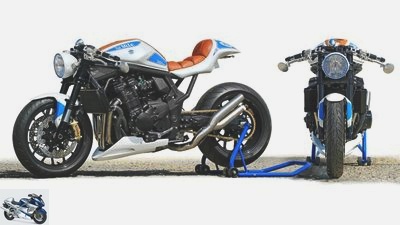
wdmyr.de
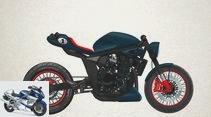

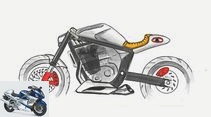
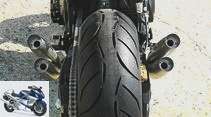
30th photos
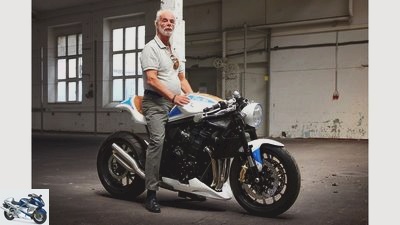
wdmyr.de
1/30
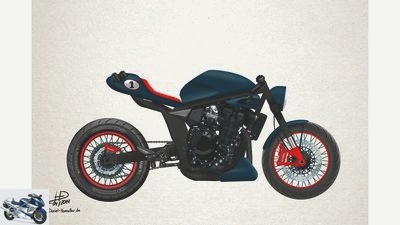
Suzuki
2/30
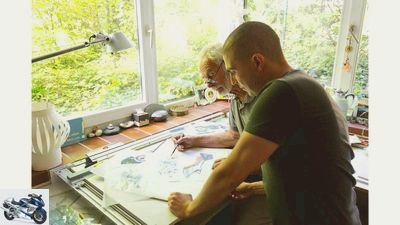
Suzuki
3/30
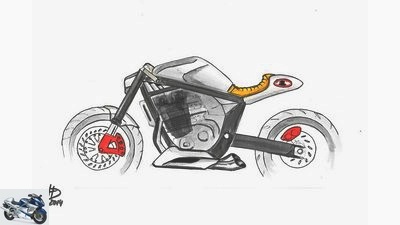
Suzuki
4/30
The first drafts of the Fat Mile were traditionally made as sketches on paper. It is easy to see where to go here.
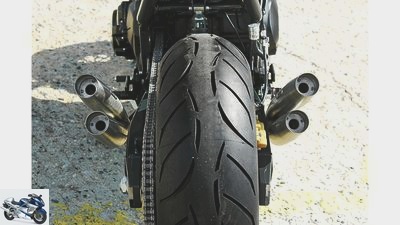
wdmyr.de
5/30
Rapid rear view: 200 mm tires from Metzeler, four filigree mufflers from Speed Products in Munster.
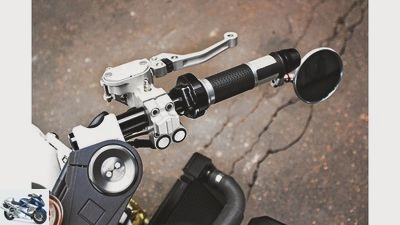
wdmyr.de
6/30
Fine parts from all over the world: ISR from Sweden contributed the fittings, the handles come from Rizoma from Italy.
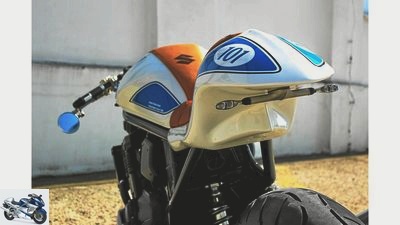
wdmyr.de
7/30
Steep line: The high rear of the Fat Mile was made of fiberglass-reinforced plastic. The small indicators are from Kellermann.
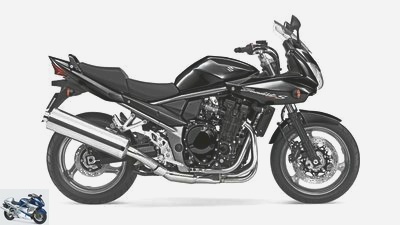
Suzuki
8/30
Obviously too conservative for today’s motorcycle world: The custom project is intended to show that the Bandit 1250 S is also a real trendsetter.
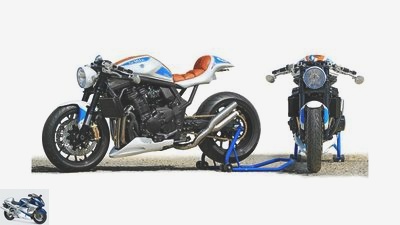
Suzuki
9/30
Suzuki Fat Mile It’s amazing how light and lively the Bandit conversion looks. The engine, frame and swing arm come directly from the good original. The short, high rear end, the filigree end bags, the unusual bench and the blue and white paintwork in custom style ensure pep.
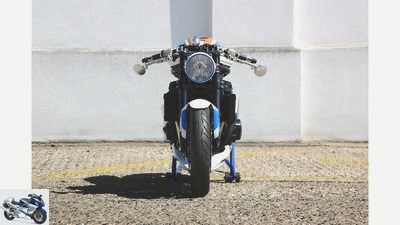
wdmyr.de
10/30
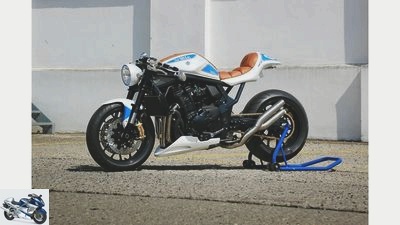
wdmyr.de
11/30
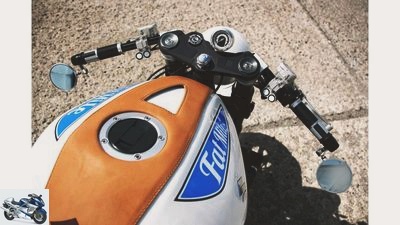
wdmyr.de
12/30
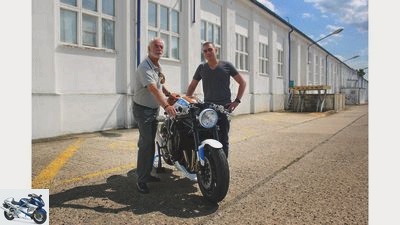
wdmyr.de
13/30
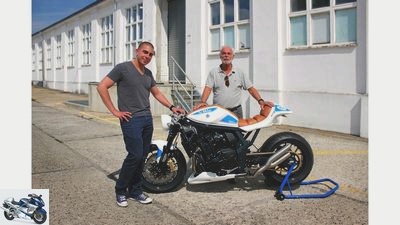
wdmyr.de
14/30
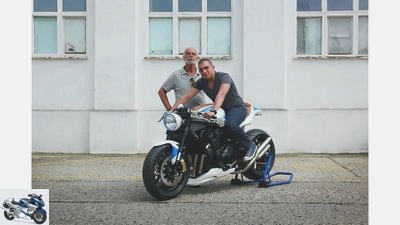
wdmyr.de
15/30
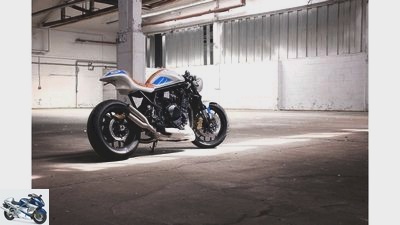
wdmyr.de
16/30
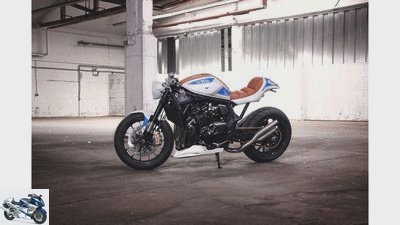
wdmyr.de
17/30

wdmyr.de
18/30
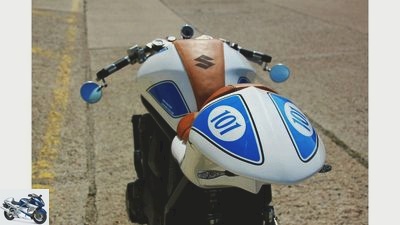
wdmyr.de
19/30
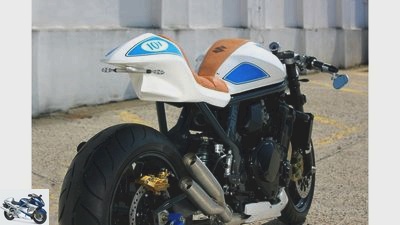
wdmyr.de
20/30
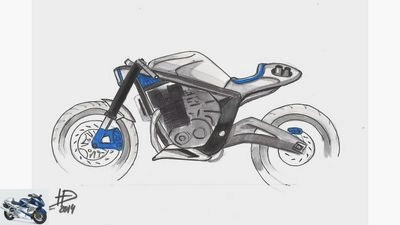
Suzuki
21/30
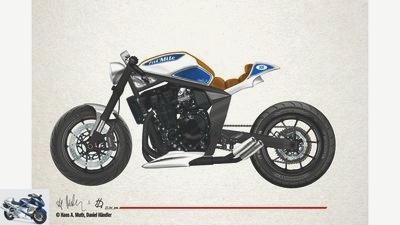
Suzuki
22/30
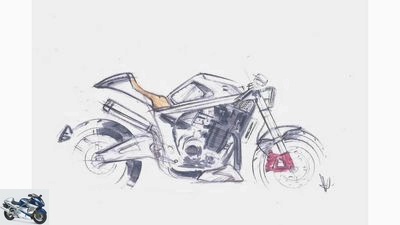
Suzuki
23/30

wdmyr.de
24/30
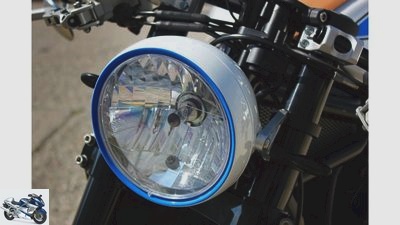
wdmyr.de
25/30
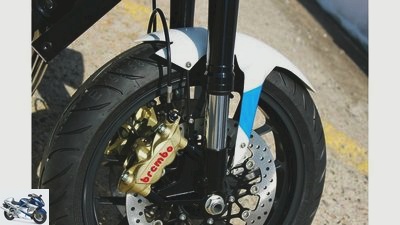
wdmyr.de
26/30
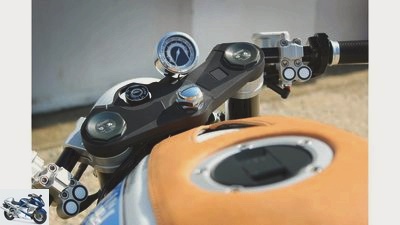
wdmyr.de
27/30
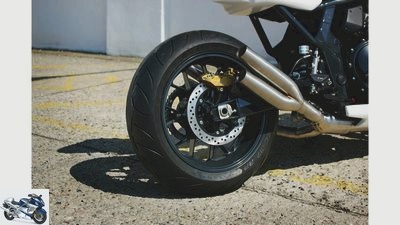
wdmyr.de
28/30
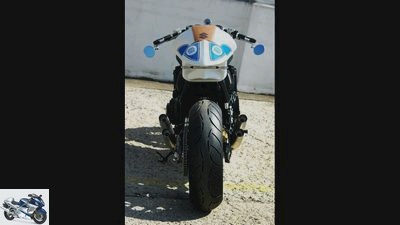
wdmyr.de
29/30
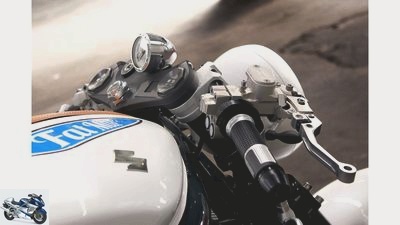
wdmyr.de
30/30
Suzuki Fat Mile
Bandit visions
What does Suzuki’s cult Bike Bandit actually do? Wallflowers to themselves, the trendsetters are currently others. Packed with ambition, Suzuki Germany had a stylish custom bandit developed: the Fat Mile. Probably also as a small suggestion for the parent company in Japan.
S.uzuki Bandit: a name like Donnerhall, a guarantee for quantities since 1995, first as 1200, then as 1250. Economical, convenient, universal – a kind of golf on two wheels. A motorcycle that with its big engine had a lot to offer everyone in some phase of life for little money. That’s how it was back then.
Buy complete article
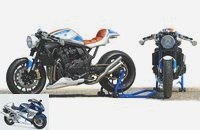
Suzuki Fat Mile
Bandit visions
The engine, frame and swing arm remain bandit
They designed a bandit that no longer has anything to do with the old 1250 S multitool, but has a lot to do with the cafe racer zeitgeist of a new scene. Suzuki Germany held back with specifications and basically only set one condition: The bandit should remain bandit. The engine, frame (of course with a revised rear frame) and swing arm were therefore taken from the original. The designers had a free hand with all other components. They designed the front fenders, front spoiler and rear section according to their own ideas, while the tank is again the original, even if it doesn’t look like it: The designers Muth and dealers achieved the fresh look with a new paint job and an additional tank strap made of leather. For the fork, they used Suzuki’s parts rack, namely the current GSX-R 1000. They combined spoked wheels from PVM and appropriate tires with the Metzeler Sportec M7RR in the 120/70 ZR 17 and 200/55 ZR 17 format.
All other ingredients that turn the brave bandit into the puristic Suzuki Fat Mile also come from the arsenal of the accessories industry. The exhaust system with two extremely filigree tailpipes on each side goes by the martial name Cobra Urban Killer, the handlebar fittings are contributed by ISR, footrests, handles, mirrors and license plate holders come from Rizoma, and the indicators – who would have thought that – can be found in the Find the Kellermann program. What you won’t find in any program in the world, however, are instructions for the harmonious interaction of these components. Here the two designers showed a fine hand.
What does the future hold??
However, the optical radical cure did not result in significant weight savings, instead of 254 kilograms like the Bandit, the Fat Mile still weighs 251 kilograms. Nevertheless, the sturdy big block with its 98 hp, but above all with the full 108 Newton meters at 3700 rpm, should have no trouble in the sprint, especially since the handlebars are now racing-wise flanged to the stanchions.
The question remains as to the future of the Fat Mile. Just a finger exercise or a hint how things could go on with the bandit? Hopefully the latter, because a 1250 S with the puristic approach of the Fat Mile would surely find new fans among the old fans. This is shown not least by the example of the BMW R nineT, which skilfully combines tradition and modernity and proves that an engine that is no longer completely fresh does not necessarily belong to the scrap heap, but simply in an appropriate environment.
In any case, Suzuki Germany is thinking carefully about offering the “Fat Mile Package” in various stages as a conversion kit. It would be even nicer, however, if the embassy from Germany met with approval from Suzuki in Japan. Then not only German bandit fans should look forward to a continuation of the success story.

Naked bike
Endurance test: Suzuki Bandit 1250 S
Balance after 50,000 kilometers
read more
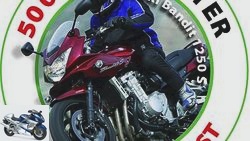
motorcycles
Endurance test interim balance of the Suzuki Bandit 1250 S
The one without
read more
Technical data Suzuki Fat Mile
Four-cylinder in-line engine, 1255 cm³, 72 kW (98 PS) at 7500 / min, 108 Nm at 3700 / min, double loop frame made of steel, upside-down fork, Ø 43 mm, two-arm swing arm made of aluminum, double disc brake at the front, disc brake at the rear, ABS , Aluminum spoked wheels, front tires 120/70 ZR 17, rear 200/55 ZR 17, weight 251 kg.
Hans A. Muth and Daniel Handler
Suzuki
Generational project: 52 years and different working methods separate the two designers Muth and Handler.
With the Fat Mile, Suzuki Germany not only wants to bring a hip custom variant of the slightly aged Bandit up for discussion, but also introduce an unusual design team: 79-year-old Hans A. Muth, who is best known, took on the development and visual implementation of the motorcycle as the father of the legendary Suzuki Katana, and the 27-year-old young designer Daniel Handler.
A place in the modern customizing world
Fat Mile: Behind this is the plan to give the honorable gray bandit a place in the modern customizing world. It also fits that the two designers come from different generations. Daniel Handler (27) studied brand design in Hamburg and did his bachelor thesis at Suzuki. It is not least thanks to him that the Bandit was chosen as the basis for the conversion: “In addition to the GSX-R, it is the typical Suzuki motorcycle,” explains the young motorcyclist. Suzuki put an experienced man at his side: Hans A. Muth (79), known as the designer of the BMW R 90 S and the Suzuki Katana. “This resulted in a kind of Senpai-Kōhai relationship, that is, between master and student, as has a tradition in Japan. And that in turn goes well with Suzuki, ”says Gerald Steinmann, Marketing Manager at the German branch.
Daniel Handler reports about the cooperation itself: “At the beginning we locked ourselves in for three days and only talked and drawn about the Fat Mile. That was enormously motivating and very instructive for me. ”Master Muth was also satisfied. “I had to remind Daniel Handler at one point or another that you have to think about the later implementation even with early drafts, but we harmonized well. I think we have designed a very successful motorcycle. “
Related articles
-
Suzuki Gladius and Kawasaki ER-6n in comparison test
Schmieder 16 pictures Jahn 1/16 Suzuki Gladius and Kawasaki ER-6n in a comparison test. Which of the 650 twin-cylinder has the edge in the end? Jahn 2/16 …
-
Suzuki Bandit: model comparison
Artist Suzuki Bandit: the models Comparison: which bandit for whom? Fat big block or a more modest 650, with or without a fairing: Suzuki does not make…
-
Suzuki GSX-R 750 and Yamaha FZ 750
Hartmann 15 pictures Hartmann 1/15 For the 100th birthday of the motorcycle 30 years ago, the most beautiful gifts came from Japan: Suzuki’s GSX-R 750, but also …
-
Art 15 pictures Jahn, Suzuki 1/15 The most powerful production motorcycle in the world continues to brake without ABS. fact 2/15 Jahn, Suzuki 3/15 The peregrine falcon in deep …
-
Review Suzuki GSX 1200 Inazuma
Test Suzuki GSX 1200 Inazuma Two point nine testers Helmut Faidt has never been faster: from zero to 100 km / h in less than three seconds. The new GSX 1200 …
-
Comparison test of naked bikes BMW R 1150 R Kawasaki ZRX 1200 Suzuki GSF 1200 Bandit
Gragolov Comparison Test Naked Bikes BMW R 1150 R Kawasaki ZRX 1200 Suzuki GSF 1200 Bandit Fat Friends Who upright and unprotected to adventure …
-
Artist comparison test middle class Honda Hornet S Kawasaki ZR-7 S Suzuki GSF 600 S Bandit Yamaha FZS 600 Fazer Born to be mild Four days, 1913 …
-
Generation comparison Suzuki 1200-1250 Bandit
Generation comparison Suzuki 1200/1250 Bandit Glorious bandits Suzuki’s extremely successful large Bandit models are the prelude to a new …
-
Suzuki motorcycle Intruder C 1800 R from 2009 – technical data
Suzuki Motorrad Intruder C 1800 R Technical data from 2009 Technical data Engine Number of cylinders, type 2, engine power 83.0 kW / 112.9 PS at 6,000 …
-
Suzuki motorcycle Intruder C 1800 R from 2012 – technical data
Suzuki Motorrad Intruder C 1800 R Technical data from 2012 Technical data Engine Number of cylinders, type 2, engine power 83.0 kW / 112.9 PS at 6,000 …